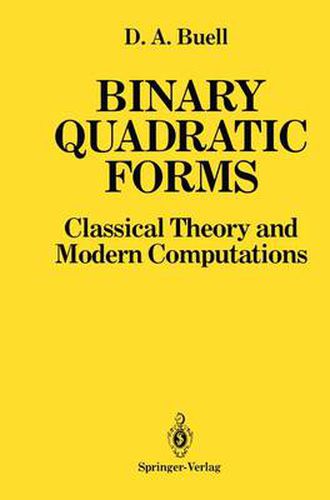Readings Newsletter
Become a Readings Member to make your shopping experience even easier.
Sign in or sign up for free!
You’re not far away from qualifying for FREE standard shipping within Australia
You’ve qualified for FREE standard shipping within Australia
The cart is loading…






This title is printed to order. This book may have been self-published. If so, we cannot guarantee the quality of the content. In the main most books will have gone through the editing process however some may not. We therefore suggest that you be aware of this before ordering this book. If in doubt check either the author or publisher’s details as we are unable to accept any returns unless they are faulty. Please contact us if you have any questions.
The first coherent exposition of the theory of binary quadratic forms was given by Gauss in the Disqnisitiones Arithmeticae. During the nine teenth century, as the theory of ideals and the rudiments of algebraic number theory were developed, it became clear that this theory of bi nary quadratic forms, so elementary and computationally explicit, was indeed just a special case of a much more elega,nt and abstract theory which, unfortunately, is not computationally explicit. In recent years the original theory has been laid aside. Gauss’s proofs, which involved brute force computations that can be done in what is essentially a two dimensional vector space, have been dropped in favor of n-dimensional arguments which prove the general theorems of algebraic number the ory. In consequence, this elegant, yet pleasantly simple, theory has been neglected even as some of its results have become extremely useful in certain computations. I find this neglect unfortunate, because binary quadratic forms have two distinct attractions. First, the subject involves explicit computa tion and many of the computer programs can be quite simple. The use of computers in experimenting with examples is both meaningful and enjoyable; one can actually discover interesting results by com puting examples, noticing patterns in the data, and then proving that the patterns result from the conclusion of some provable theorem.
$9.00 standard shipping within Australia
FREE standard shipping within Australia for orders over $100.00
Express & International shipping calculated at checkout
This title is printed to order. This book may have been self-published. If so, we cannot guarantee the quality of the content. In the main most books will have gone through the editing process however some may not. We therefore suggest that you be aware of this before ordering this book. If in doubt check either the author or publisher’s details as we are unable to accept any returns unless they are faulty. Please contact us if you have any questions.
The first coherent exposition of the theory of binary quadratic forms was given by Gauss in the Disqnisitiones Arithmeticae. During the nine teenth century, as the theory of ideals and the rudiments of algebraic number theory were developed, it became clear that this theory of bi nary quadratic forms, so elementary and computationally explicit, was indeed just a special case of a much more elega,nt and abstract theory which, unfortunately, is not computationally explicit. In recent years the original theory has been laid aside. Gauss’s proofs, which involved brute force computations that can be done in what is essentially a two dimensional vector space, have been dropped in favor of n-dimensional arguments which prove the general theorems of algebraic number the ory. In consequence, this elegant, yet pleasantly simple, theory has been neglected even as some of its results have become extremely useful in certain computations. I find this neglect unfortunate, because binary quadratic forms have two distinct attractions. First, the subject involves explicit computa tion and many of the computer programs can be quite simple. The use of computers in experimenting with examples is both meaningful and enjoyable; one can actually discover interesting results by com puting examples, noticing patterns in the data, and then proving that the patterns result from the conclusion of some provable theorem.